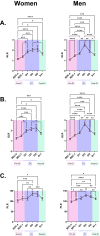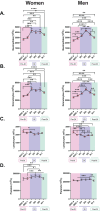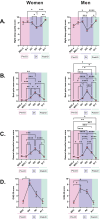ESA VIVALDI Dry Immersion Microgravity Simulations Induce Increases in Immune Biomarkers Associated With Physical and Psychological Stress, and Sex-Specific Factors
- PMID: 40892712
- PMCID: PMC12404282
- DOI: 10.1096/fj.202502198R
ESA VIVALDI Dry Immersion Microgravity Simulations Induce Increases in Immune Biomarkers Associated With Physical and Psychological Stress, and Sex-Specific Factors
Abstract
With future manned space projects involving missions of unprecedented duration, multisystem deconditioning induced by spaceflight could seriously affect the well-being and health of astronauts. Safe and easily determined in-flight biomarkers are therefore needed to monitor health status. In this study, we simulated space deconditioning with a 5-day dry immersion (DI) of 18 healthy women and 19 healthy men and evaluated the effects of this protocol on three biomarkers: the neutrophil-to-lymphocyte ratio (NLR), the granulocyte-to-lymphocyte ratio (GLR) and the platelet-to-lymphocyte ratio (PLR). Increases in all three ratios were observed in both men and women, as also observed at the end of a space mission or after exposure to simulated microgravity. These increases were associated with physical and psychological stress in both sexes. Furthermore, our work suggested a positive link between NLR increase and cardiovascular system alteration in women, whereas in men, there would be a positive relationship between NLR, GLR, PLR, and inflammation. Thus, in addition to physical and psychological stress, sex-specific factors could contribute to increases in NLR, GLR, and PLR ratios during DI. As for the increase in PLR, it did not predict the development of long-lasting immune diseases during DI, in contrast to 2 months of head-down tilt bed rest (HDBR), another spaceflight analog. These data show that the NLR, GLR, and PLR ratios are promising biomarkers that deserve further study to determine the relationships between their increase and microgravity-induced deconditioning. These dry immersion investigations are registered at clinicaltrials.gov as NCT05043974 for women and NCT05493176 for men.
Keywords: astronaut health; biomarker; deep‐space missions; ground‐based model; monitoring; peripheral blood cells; physical stress; vascular system.
© 2025 The Author(s). The FASEB Journal published by Wiley Periodicals LLC on behalf of Federation of American Societies for Experimental Biology.
Conflict of interest statement
The authors declare no conflicts of interest.
Figures




References
-
- Jacob P., Bonnefoy J., Ghislin S., and Frippiat J.‐P., “Long‐Duration Head‐Down Tilt Bed Rest Confirms the Relevance of the Neutrophil to Lymphocyte Ratio and Suggests Coupling It With the Platelet to Lymphocyte Ratio to Monitor the Immune Health of Astronauts,” Frontiers in Immunology 13 (2022): 952928. - PMC - PubMed
-
- Atik Y. T., Cimen H. I., Gul D., Arslan S., Kose O., and Halis F., “Are the Preoperative Neutrophil/Lymphocyte Ratio and Platelet/Lymphocyte Ratio Predictive for Lamina Propria Invasion in Aging Patients?,” Aging Male 23 (2020): 1528–1532. - PubMed
-
- Dillon K., Goodman Z. T., Kaur S. S., Levin B., and McIntosh R., “Neutrophil‐To‐Lymphocyte Ratio Amplifies the Effects of Aging on Decrements in Grip Strength and Its Functional Neural Underpinnings,” Journals of Gerontology. Series A, Biological Sciences and Medical Sciences 78 (2023): 882–889. - PMC - PubMed
Publication types
MeSH terms
Substances
Associated data
Grants and funding
LinkOut - more resources
Full Text Sources
Medical
Research Materials

